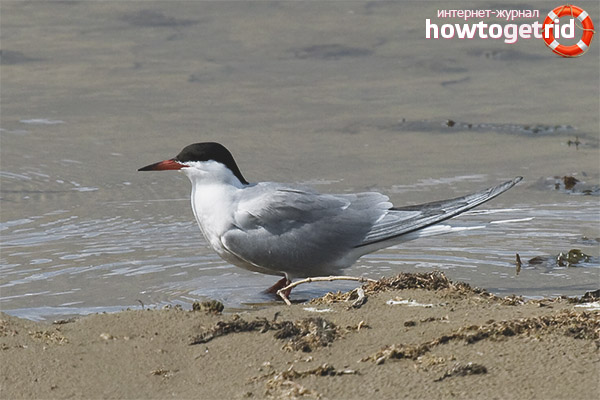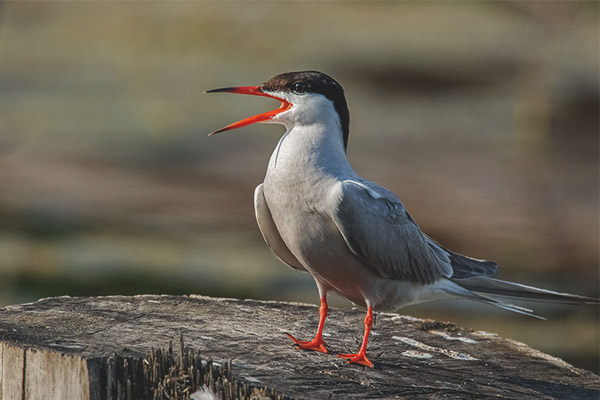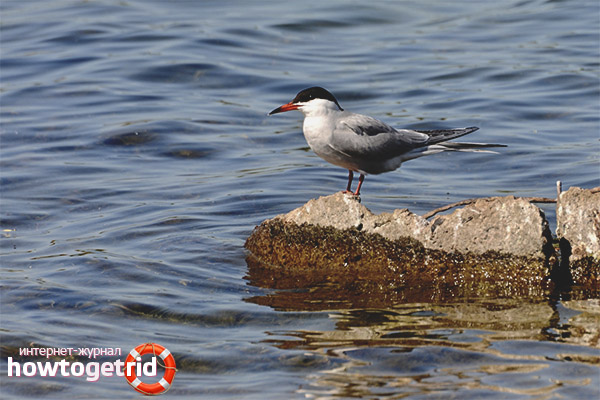The content of the article
Being in nature in close proximity to rivers or freshwater lakes, many people had to meet medium-sized and completely unremarkable birds with long, thin wings. Many believe that gulls have a characteristic resemblance to birds. In fact, they belong to the order of charadriiformes. They are distinguished by a peculiar manner of flight and a hoarse voice resound in disturbing moments. This species of birds is widespread, and prefers to arrange their lives in large colonies. Despite their large numbers, these birds are quite vulnerable, in particular, people cause damage to them.
Appearance
The tern does not have any outstanding characteristics, it has become widespread in latitudes located to the south relative to the tundra zone.This bird, possessing an elegant silhouette, is similar in size to a wild pigeon. Tern length from tail to beak reaches 35 centimeters, but its wingspan is disproportionately large and is about 80 centimeters. The weight of an adult individual reaches 180 grams.
The plumage of a bird differs in inconspicuous coloring, which consists of off-white or light-gray tones. On the head of the bird is a zone consisting of black plumage, which has a glossy sheen and looks like a cap. Only the red beak of the bird is painted in bright colors, rolling on the end in black and its bright red legs. When giving sound signals, the common tern makes abrupt sounds, in a rather creaky voice.
By its appearance, the bird is, in fact, very similar to a small gull, but the tern is distinguished by wings having a narrower and elongated shape. The following difference is the inconspicuous feathered tail, which consists of two pointed parts, in the manner of a dovetail. And the characteristic distinction that gives out the tern is the black cap on its head.
Common tern habitat overview
It is a migratory bird, with the arrival of winter, large colonies of terns fly to equatorial or southern latitudes of the planet. In winter, the bird can be found in New Guinea or on the African continent, as well as in the Philippines or in western South America. Nesting of the common tern was recorded in some areas of the tundra, but unlike the polar relative, it is attracted only by the river valleys. In the remaining parts of the northern expanses it is impossible to meet her.
As an acceptable habitat, the tern chooses a spit of water, with a surface of pebbles or sand. Also suitable for it are lowlands associated with the coast of water bodies, flat parts of the sea coast, valleys of various rivers.The bird prefers flat areas of the coast for nests, but it can also arrange its nests in mountainous areas up to 5,000 meters high - such places were found in the Pamirs and also in Tibet. According to ornithologists, for their settlements the common tern adheres to bodies of water with stagnant water or quiet rivers with moderate currents.
Poultry diet

The tern is an excellent hunter with an enviable skill. The basis of the menu of the bird is largely made up of various mollusks and small fish. Having spotted her prey, in shallow water or on the surface of the water, she makes a virtuoso throw, sometimes going under water with her head, leaving only wings on the surface. The technique of such throws is honed to such an extent that the bird very rarely misses.
Favorite hunting places of the flight master are shallows or sandbars of sand reclaimed by water, which can be found in abundance in the coastal regions of large rivers. The ideal hunting place for these predators is located in shallow water, which always attracts fry, which are the main goal of the terns.The bird makes a smooth circling of the hunting ground, sometimes hovering in one place, as a rule, before the next throw. In case of an unsuccessful lunge, the attempt has to be repeated from the beginning.
In addition to river dwellers, her diet includes a variety of insects, which she can pick up on the fly, using the same techniques as the swallow, and from the ground in her hunt. In the selection of insects, the tern is completely unintelligible, and exterminating numerous pests is of great benefit.
During the hatching of birds, birds are able to patrol vast territories, searching for prey. According to experts, the distance of flights can reach 26 kilometers. It is believed that, living in large colonies, these birds can cause significant damage to all sorts of fisheries, exterminating fry. But the threat here is clearly exaggerated, because the terns do not hunt in packs, and the subject of their hunt is fish of non-target species.
Peculiarities of tern behavior in the period of hatching
Puberty occurs in the tern when it reaches 3-4 years old.Birds are characterized by monogamous features of building relationships and are able to maintain contact for several seasons.
Terns males have a very active manner of behavior during the mating season. The dance of the temperamental gentleman consists of an aggressive demonstration of its attractiveness. He takes a curved pose, lowers his beak down to a vertical position, and tail pushes up. By adopting this position, makes circular motions, making, at the same time, breathtaking sounds.
For the construction of its nests, the common tern prefers to occupy grounds on the sand banks of ponds with a sandy surface or consisting of pebbles. On the nesting grounds they are settled in large colonies, quite often in the neighborhood with other birds. They are forced to take such a position, primarily because of fear of invasion by predators, because such birds alone cannot resist even a non-representative adversary. But, being in a large colony, by common efforts they can collectively rebuff predators with fairly large sizes, striking alternately numerous beats with their beaks and stunning them with a frantic roar consisting of many voices.
In places where beach lovers nest, there is practically no vegetation, and birds make their nests right on the soil surface. The nest receives the appearance of a small depression in the soil, which is subsequently lined with litter consisting of dried grass and feathers. The nest in its cross section at the common tern does not exceed 10 centimeters.
The process of breeding offspring river dweller
In the nest of the river tern, on average, it turns out to be 3 eggs, in rare cases there may be four. The color of the masonry is dominated by green shades, it may be a color similar to ocher or olives, covered with dark brown spots. Eggs are quite small in size, up to 5 centimeters in length and about 3 centimeters in width.
The female tern begins the continuous process of hatching from the moment of the appearance of the first egg; the incubation period of the bird does not exceed 22 days.Both partners are busy hatching eggs, the female is most often on the clutch at night, and during the day the male comes to replace it. The first chicks appear in early July, and in early August they already have the ability to carry out full-fledged flights. This period begins approximately 25 days after the birth of the chicks. The process of breeding offspring does not take a long time from the tern.
Video: common tern (Sterna hirundo)












To send